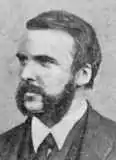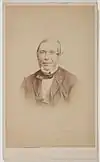Barcroft Capel Boake
Barcroft Capel Boake (12 November 1838 – 1921) was an Australian photographer.[1] He is most famous for his mosaic of the New South Wales Contingent produced in 1885 which represents the soldiers returned from the war in Sudan.[2]
Barcroft Capel Boake | |
|---|---|
 | |
| Born | 12 November 1838 Dublin, Ireland |
| Died | 1921 (aged 82–83) Victoria, Australia |
| Occupation | Photographer |
| Nationality | Australia |
| Spouse | Florence Eva Clark |
Personal life

Barcroft was born in Dublin, Ireland on 12 November 1838. Boake migrated after seeking advice from his cousin, a Rev. at Holy Trinity Church, Balaclava, Victoria. He moved to Melbourne, Victoria in the 1850s, and then moved on to live in Sydney in 1858. He arrived with some experience and knowledge of photography and worked at Freeman's studio in Sydney for many years.[3] While in Sydney he married Florence Eva Clark in 1865.[4] He settled in Sydney working in his own photographic studio at 330 George St, Sydney[5] up until 1866, when he then declared bankruptcy and moved to Daylesford, Vic. He spent the rest of his life there until his death at the age of 83, February 1921.[6]
A.G.Stephens
Although struggling with personal life tragedies and economic worries he was one of the most successful and popular professional photographers of the latter half of the 19th century. He did however spend the last 30 years of his life in obscurity.[4]
B.C.Boake fathered a son in 1866, Barcroft Henry Thomas Boake was born in Balmain, Sydney, on 26 March.[7] Boake Junior was born the year B.C.Boake left Freeman's studio. He was a talented poet that left home at the age of 17, struggling with bouts of depression. In 1892, during the year of the bank crisis, Barcrot Boake junior was found dead. He had returned home to his father, who was bankrupt. At this stage not much was left to salvage in B.C.Boake's life. His wife had died a number of years prior, now his son.
A.G.Stephens
He had daughters that were now married and living away from his home that had been sold. Also his studio and all other possessions were now lost, sold to creditors due to his bankruptcy. This is when he decided to live his life in a quiet and small town, Daylesford, Victoria. He opened a small one man studio and worked their for many years. His life ended in an accident, while smoking a pipe he fell asleep and his beard caught on fire, and he burned to death.[8]
Photography career


After migrating to Australia, Barcroft Capel Boake spent majority of his working life in Sydney.[9] He had a hugely successful business. Owning and running his own studio on George St, where he explored the streets and buildings of Sydney through his wet plate work. These outdoor prints would be sold as whole albums. His most successful works are of his male subjects. However his images of women and children were collected in albums, as the small delicately coloured prints are considered the best of that period and time of portrait photography. The highly persevered state of his prints suggest that people of the time went to Boake for charming miniatures.[8] He volunteered as a captain in the 7th Battery of New South Wales Voluntary Artillery. Here Boake made his most famous work, the mosaic of the returning New South Wales contingent that fought in the Sudan campaign of 1890.[9] Capel practiced in many different photographic printing and developing techniques. The heliograph and the instantaneous process were ways Boake was able to maintain the fine art quality of his execution. The competitors from other local studios moved to larger prints, while Boake maintained his artistic reputation, working on finer photographs.[9] Barcroft was also often seen using, a carte de visite, which is 10 x 6.4 cm stiff card, with a paper photograph attached, invented in 1854 by André-Adolphe-Eugène Disderi.[9]
New South Wales Contingent mosaic

In 1885, the greatest mosaic of the nineteenth century was made by Barcroft Capel Boake. The mosaic was made during the return from war in Sudan, of the New South Wales Contingent. Portraits of the men of war were placed and stuck onto a black and gilt banner. The photographs of the men were arranged in a swirl around the main expedition leaders. Some say they resemble the rings of Saturn. The mosaic measured 175 centimetres tall by 200 centimetres wide. This was the finest hour in Boake's career as a photographer.[2]
The portraits and group portraits were created at the return of the New South Wales, Australian Contingent. Soon after they arrived home Boake began his work with the soldiers, the Colonial and Indian Exhibition featured the photographic portraits and work. Many hundreds of copies were sold as keepsakes and art. Recently a canvas banner was rediscovered with a giant version of the print on it. It was rediscovered at the Australian War Memorial. The existence of this copy and slightly different versions of the photographic mosaic, suggest another banner might be in existence somewhere waiting to be discovered.[2]
Sir H. Ponsonby
An article was published in the Sydney Morning Herald, in the "News of the Day" header. The mosaic was planned to be used to preserve the memory of the members of the New South Wales Contingent. The Banner was presented to her Majesty Queen Victoria and subsequently Boake received a letter thanking him for his mosaic from Sir H Ponsonby, through the Agent-General. Boake informed the paper that he had begun making copies. The first duplicate of the mosaic was on view at his George street studio.[10]
References
- Newton, Gael (1988). Shades of Light. Canberra: Australian National Gallery. p. 37. ISBN 0642081522.
- Newton, Gael (1988). Shades of Light. Canberra: Australian National Gallery. p. 36. ISBN 0642081522.
- Cato, Jack (1977). The story of the camera in Australia (2nd ed.). Melbourne: Institute of Australian Photography. p. 41. ISBN 0959683909.
- "Design and Art online Australia". www.daao.org.au. Retrieved 25 March 2015.
- Cato, Jack (1977). The story of the camera in Australia (2nd ed.). Melbourne: Institute of Australian Photography. p. 42. ISBN 0959683909.
- Smith, Ann G; Gibbney, H J (1987). A BIOGRAPHICAL REGISTER Volume I A-K. Canberra: Australian Dictionary of Biography Australian National University, Canberra. ISBN 0731501047.
- "Australian Dictionary of Biography". www.adb.anu.edu.au/. Retrieved 24 March 2015.
- Cato, Jack (1977). The story of the camera in Australia (2nd ed.). Melbourne: Institute of Australian Photography. p. 43. ISBN 0959683909.
- "Art Gallery of New South Wales". www.artgallery.nsw.gov.au/. Retrieved 25 March 2015.
- "News of the day". The Sydney Morning Herald 1842 – 1954. National Library of Australia. 19 April 1887. p. 7. Retrieved 26 March 2015.